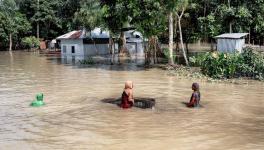Kerala: Temperatures Soar in Several Districts, Isolated Rain Brings Minor Relief
Image Courtesy: Wikimedia Commons
The state continues to reel under high temperatures, much before the summer has arrived. The Kerala State Disaster Management Authority (KSDMA) published a heat wave index for the first time on March 9, in which places in at least five districts registered a heat index of 54 degrees Celsius.
Even as some parts of the state are witnessing isolated rains, set to continue till March 17, the lower humidity and higher temperatures are leading to warnings from the state government and the KSDMA.
Most parts of the state were placed under the 'feel' category as per the information collected from the automated weather stations (AWS) after recording temperatures around 37-39 degrees Celsius.
The increase in temperature has led to an increase in electricity consumption, with the demand increasing to 4,494 MW on March 14, as compared to the peak demand of 4,385 MW recorded on April 27, 2022.
The government has installed water kiosks in local bodies, which will supply cold water, buttermilk and ORS to those in need, as the KSDMA has published a standard operating procedure to be followed during the season.
FIVE DISTRICTS UNDER 'DANGER ZONE'
The KSDMA published the heat wave index, prepared based on the combination of temperature and humidity; it warned the public to exercise caution owing to the increasing temperature across districts and possible sunburn events in Thiruvananthapuram, Kottayam, Alappuzha, Pathanamthitta, and Kozhikode districts.
Only Idukki and Wayanad, the hilly districts, parts of Kasargod and surprisingly, Palakkad, known for its dry and hot climate, are recording lower temperatures (under 29 degrees Celsius) than the other districts.
The KSDMA report suggested that the temperatures in most parts of the state were severely hot (heat index between 40-45 degrees Celsius), a condition under which prolonged exposure to sunlight could cause fatigue. Certain parts of Thiruvananthapuram, Alappuzha, and Kozhikode were recording heat indexes of 45-54 degrees Celsius, implying a higher possibility of sunburns.
'HUMIDITY STILL LESS'
As per the data available from the Integrated Rural Technology Centre (IRTC) of the Kerala Sastra Sahitya Parishad (KSSP), the humidity levels compared to the previous years in February are low this year. The KSSP is attached to the All India Peoples Science Network (AIPSN).
AN Sivadasan, head of the Weather Lab at the IRTC in Palakkad, speaking to Newsclick, said, "The humidity levels in February this year was below 50% for 23 days. Whereas in 2022, it was exactly the opposite. In a way, the lower humidity in the air prevents the human body from evaporating the sweat, leading to an imbalance in body temperature."
Meanwhile, the night temperature in the month is also considerably lower compared to the previous two years.
"The minimum temperature in February 2023 was below 20 degrees Celsius for most days, while in the previous two years, it never fell below 20 degrees Celsius. The numbers recorded are particularly interesting," Sivadasan added.
"The lower rainfall in December last year, leading to low moisture in the ground, could also be a possible reason," he added.
Though the total rainfall deficit during the Northeast Monsoon (NEM) was -3.84%, nine of the 14 districts recorded a higher deficit, with five districts recording 20% below-normal rainfall.
42-YEAR HIGH TEMPERATURES IN SEVEN DISTRICTS
The study by the Centre for Water Resource Development and Management (CWRDM) has concluded that the temperature in seven districts in January, February and March has increased by 0.2-1.6 degrees Celsius. The districts which recorded an increase in temperature are Alappuzha, Kottayam, Kozhikode, Wayanad, Palakkad, Kannur and Kasaragod districts.
The report has also indicated a possibility of drought in the coming months, at least till May, and a crop loss of around 6-14%.
"Climate Change is a major reason for such events happening across Kerala and other parts of the world. Any science organisation would root for a reduction in the emission of greenhouse gases to prevent further damage to the environment while requesting the people to follow the government's guidelines to stay safe from such extreme weather events," Sathasivan said.
Heat waves result from warm air being pushed to the ground by the movement of high pressure in the atmosphere. Such instances can minimise the cloud cover and wind, extending the persistence of heat waves.
Get the latest reports & analysis with people's perspective on Protests, movements & deep analytical videos, discussions of the current affairs in your Telegram app. Subscribe to NewsClick's Telegram channel & get Real-Time updates on stories, as they get published on our website.























